I came up with this recipe for Vegan Sausage using Okara, the gritty pulp byproduct from making Homemade Soy Milk, to reduce the amount of food waste in my kitchen. Mix and match with different seasonings to mimic your favourite sausage flavour, or start with one of the Spice Mixes recommendations below.

Easy Beginner Seitan Recipe
I like to call this okara sausage a “gateway” recipe. It’s perfect for beginners who are looking to get into seitan-making because:
- It’s made with VWG, which is easy to work with
- All you do is mix together the ingredients in one bowl and steam. No kneading, no stretching, no fancy techniques
- Only 7 ingredients are needed
You’ll be shocked at how effortless it is to make delicious sausages at home!
If you’re interested in learning more about seitan, and maybe exploring more advanced techniques, I recommend checking out the guides on Seitan Society.
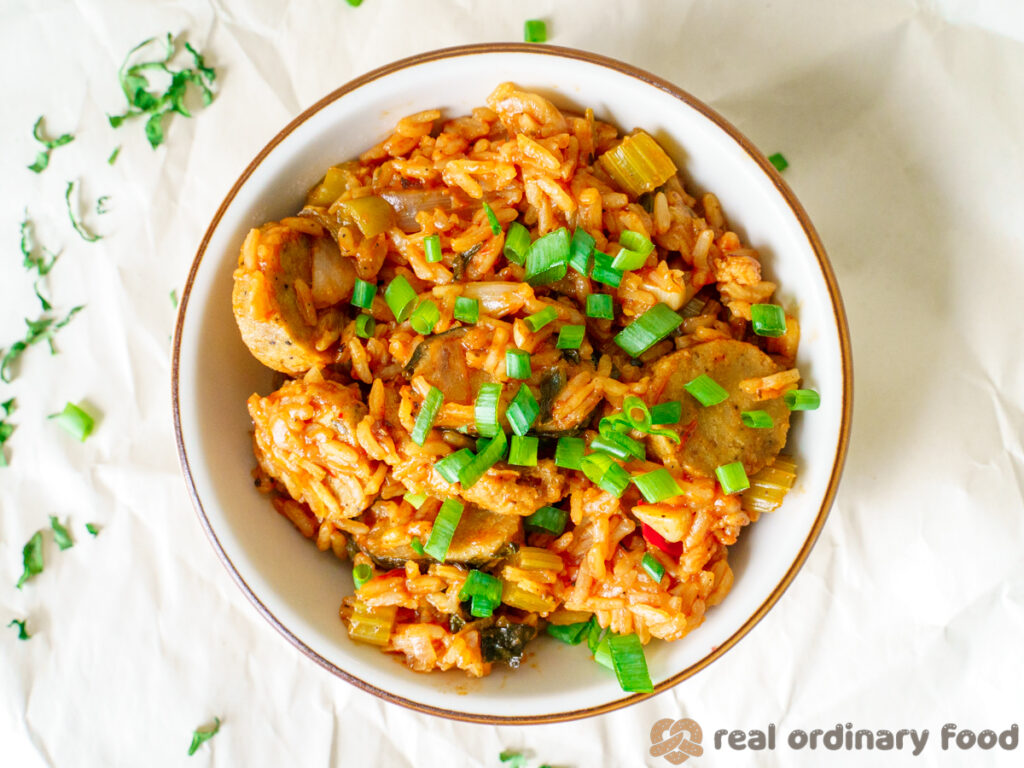
VWG vs WTF
Okay so if you’ve done research into seitan recipes you may have stumbled across these two terms: VWG and WTF. And now you’re wondering WTF is WTF…
These acronyms refer to the two basic ways one can make seitan at home.
- The VWG or “vital wheat gluten” method uses vital wheat gluten, aka gluten flour. Gluten is a protein that is responsible for the wonderfully meat-like properties of seitan. So a VWG recipe takes that purified protein and mixes it with other stuff to create seitan. (You can buy vital wheat gluten flour at Bulk Barn or Qualifirst here in Canada, or even Amazon, though the first two options are cheaper.) This okara sausage recipe uses the VWG approach.
- The WTF or “wash the flour” method starts with plain old all purpose flour. All wheat flours contain gluten (hence why gluten-free folks need to stay away from wheat products), but it’s mixed in with a bunch of other stuff. To isolate the gluten, you first knead together a dough ball as if you were making bread, then literally wash it repeatedly in a bowl of water until all the starch falls away and you’re left with a spongy, gloopy, mesh-like network of pure gluten. This method takes a lot longer and is more tedious than VWG method, which is why VWG is more approachable for beginners.
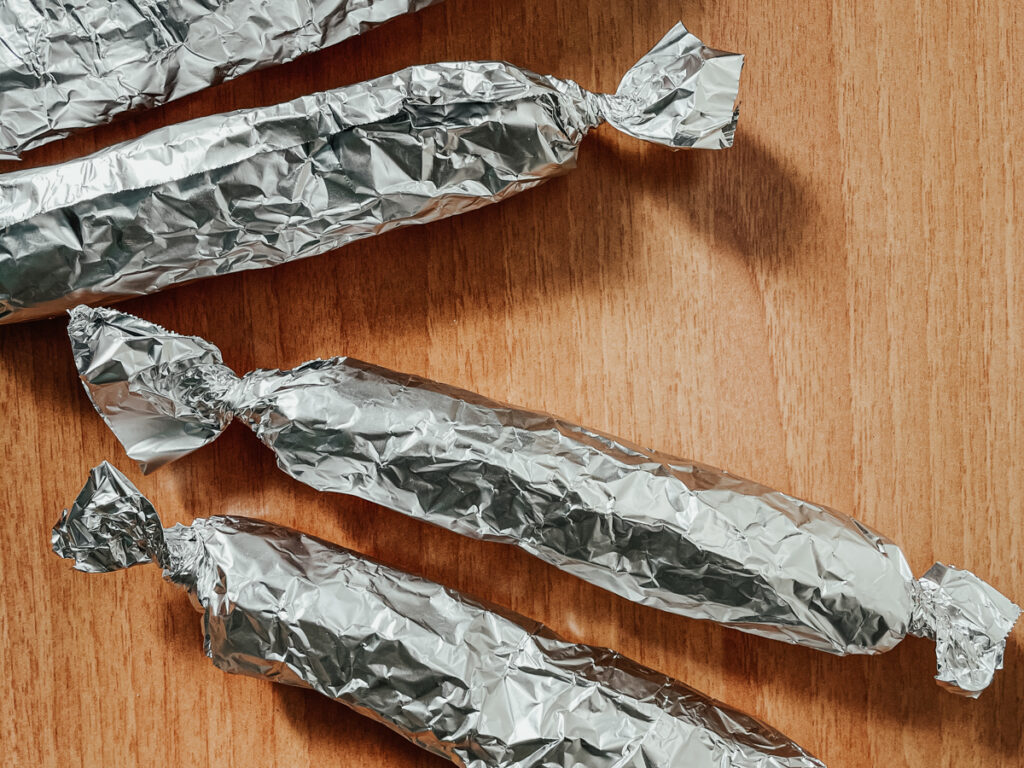
Imo, VWG is best for sausage recipes as it emulates the firm, homogenous texture of sausages. However, WTF can be more versatile and depending on how you handle it, results in a number of different final textures that can simulate other types of meats. If you’re interested in learning how to WTF, check out this detailed step-by-step guide.)
Results of My Tests
A good vegan sausage should have a good chewy texture to mimic the texture of real meat, but shouldn’t be too rubbery. Where a sausage lands on the spectrum between doughy and rubbery comes down to the percentage of vital wheat gluten in the mixture. The less gluten, the more crumbly and doughy. The more gluten, the more bouncy and rubbery.
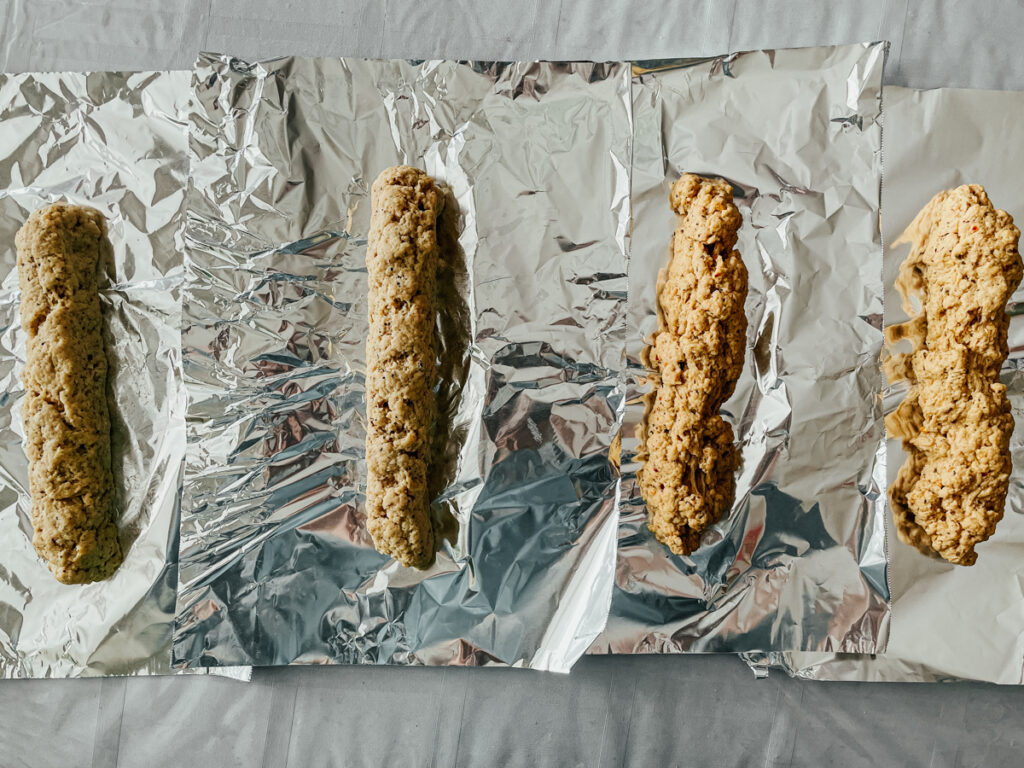
On my first attempt, I used nearly the entire batch of okara and only 1 cup of vital wheat gluten. This resulted in a very gritty, almost crumbly sausage that offered no resistance when I bit down. Big disappointment.
For attempt #2, I cut down the okara to only half of what I used before. The texture improved a lot but it was still a tad too doughy and soft. I wasn’t entirely satisfied.
For the final trial, I stuck with the same amount of okara as attempt #2 but I also increased the vital wheat gluten by 1/2 cup. I also added a little more soy milk to make the dough easier to work with, plus a spoonful of tomato paste to add some savoury oomph. Success! The texture was nice and firm with a good bite to it.
Spice Mixes
Each of the following mixes make enough to season 1 batch of vegan okara sausage (6 links).
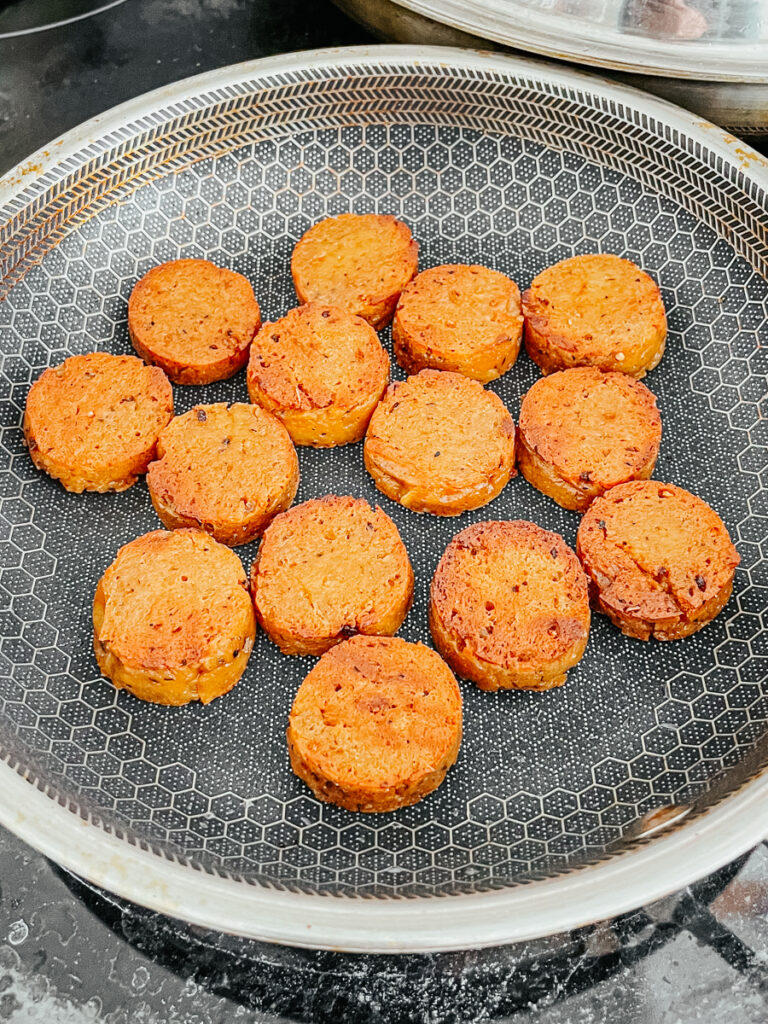
Andouille Sausage
I make these smoky Andouille sausages all the time to add into my Proper Vegan Gumbo.
- 2 cloves garlic, minced
- 1 tsp onion powder
- 1 tsp paprika
- 1 tsp cayenne pepper
- 1/2 tsp ground black pepper
- 1/2 tsp dried thyme
- 1 tsp liquid smoke
- 1/4 tsp allspice *optional
If you’re lazy, you can also use 1 tbsp (8 g) of storebought Cajun or Creole seasoning + 1 tsp liquid smoke instead of all the separate spices above.
Boerewors
[TBA. Boerewors is a South African sausage. Still experimenting with spice combos for this flavour.]
Bratwurst
The bratwurst is one of Germany’s most famous sausages. It’s commonly eaten with potato salad or sauerkraut but can also be served on a bread roll. Just like English bangers (see below), bratwurst refers to a big familiy of sausages. Every region has their own version, but the differences mainly come from the mix of meat or the weight of the sausage. Most share similar spice profiles.
- 3 cloves garlic, minced
- 2 tsp lemon zest
- 2 tsp marjoram
- 1 tsp white pepper
- 1 tsp caraway seeds
- 1/2 tsp freshly grated nutmeg
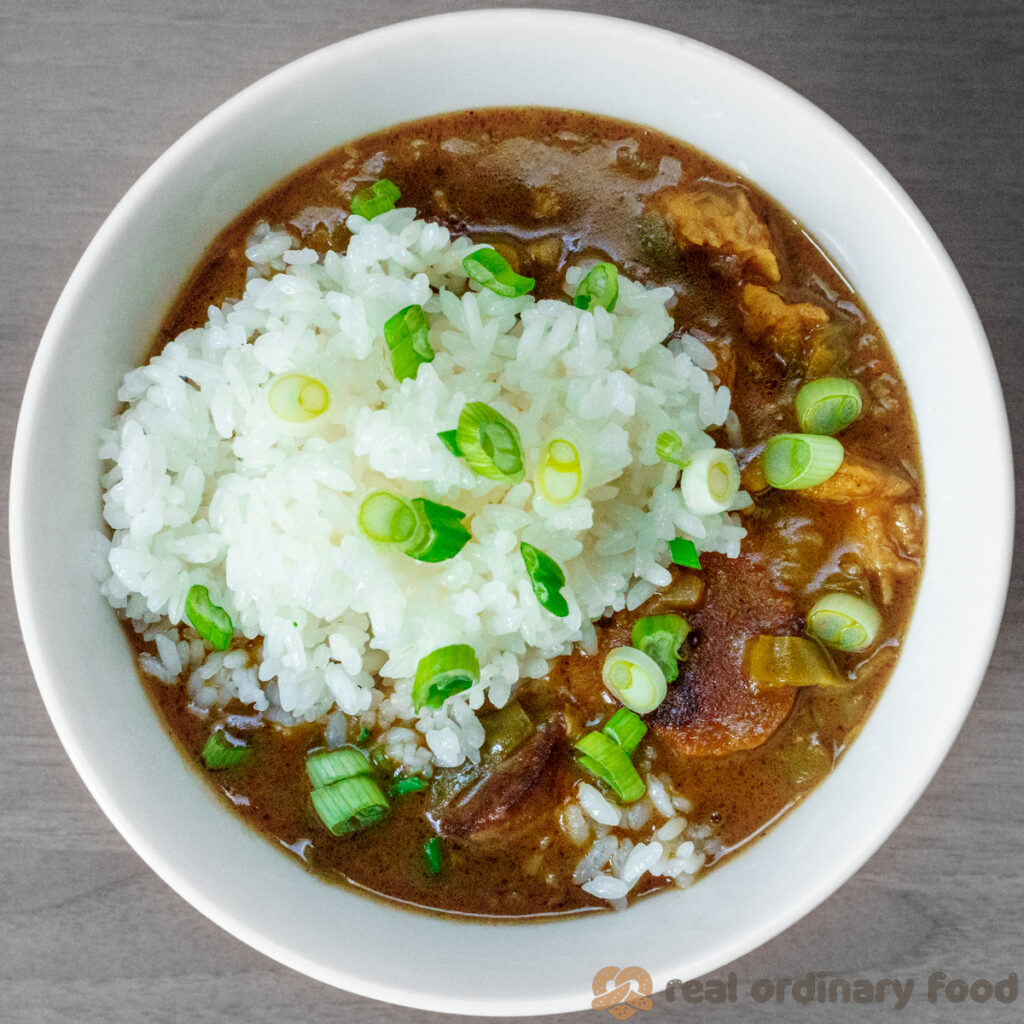
Chorizo
[TBA. Chorizo is a sausage with both Spanish and Mexican varieties. Still experimenting with spice combos for this flavour.]
Cumberland Sausage (for Bangers and Mash)
Bangers are uniquely British sausages frequently eaten for breakfast as part of “bangers and mash” (sausage and mashed potatoes). The word banger is actually an umbrella term that encompasses many regional varieties of sausages. However, one of these regional specialties, the Cumberland sausage, is especially famous in the bangers and mash ensemble.
- 1 tsp ground black pepper
- 1/4 whole nutmeg, freshly grated
- 1/2 tsp ground ginger
- 1 tsp ground sage
- 1/2 tsp dried thyme
- 1 tsp blackstrap molasses or carob molasses
- 1/2 tsp cayenne pepper
Frankfurter or Vienna Sausage (Hot Dog Wiener)
In Canada and the States, Franks and Viennas are pretty much used interchangeably to refer to the smooth, pink sausage most popularly eaten in a hot dog bun or straight out of a can with tomato sauce/BBQ sauce. Roughly speaking: Frankfurters are used for hot dogs while Vienna sausages are the short ones that come in cans. But there is no real strict definition for either of these names, at least in North America.
- 1 tsp onion powder
- 1 tsp ground black pepper
- 1/2 tsp ground coriander
- 1/8 tsp ground cardamom
- 1/8 tsp ground cloves
- 1/8 tsp freshly grated nutmeg
- 1/8 tsp mace *optional
- 1/2 tsp chili powder
- 1/2 tsp liquid smoke *optional; these sausages are typically unsmoked but when I make these hot dogs I like to add a dash of smoky flavour 🙂
These sausages are best known for being the hot dog wiener of choice, but you can use them in many other ways:
- Chopped up into breakfast hash
- Add them to spaghetti with tomato sauce
- Sliced and added to budae jjigae (Korean army stew)
- Roll them up into pigs in a blanket (sausage roll for you Brits)
Chicken Sausage
I haven’t worked on a spice blend recipe of my own for this one, because I’ve discovered an amazing seasoning that is made locally here in Calgary: Mesmerize Spices. 1 tbsp (12 g) of their Calgary Steak Spice makes this sausage recipe taste sooo much like a black pepper chicken or turkey sausage. (I mean, tbf, it’s been a while since I’ve had any kind of meat sausage, but this seasoning immediately evoked my old memories.)
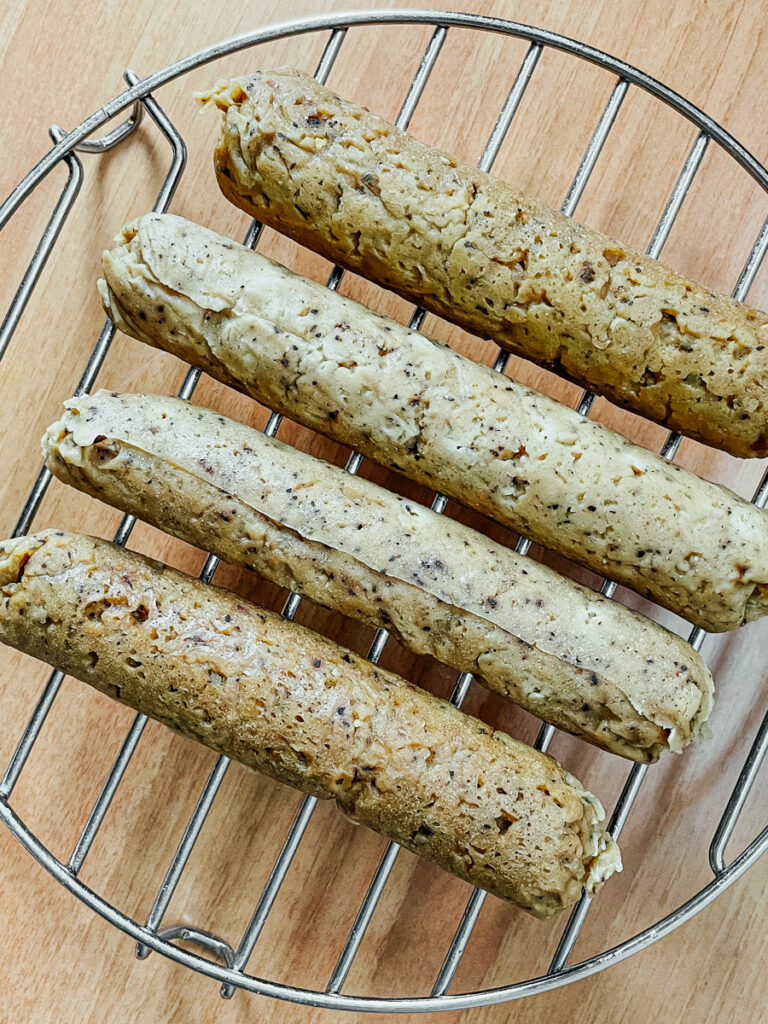
You can use this sausage in place of Andouille in gumbos and jambalayas. I also love adding it to tofu scrambles.
(Note: The Steak Spice already contains plenty of salt. Leave out the 2 tbsp maggi sauce or soy sauce if you’re using this flavour.)
Kiełbasa Polska (Polish Hot Dog)
Kielbasa is another hearty choice for filling hot dog buns. (Anyone remember the Polish dogs in the Costco food court?) They’re also a good all-purpose sausage that can be tossed into a stir fry, mixed in with pasta, or substituted for most of the other sausage flavours on here.
- 3 cloves garlic, minced
- 1 tsp ground black pepper
- 1 tsp onion powder
- 1 tsp caraway seeds
- 1 tsp marjoram
- 1/4 tsp allspice
- 1/2 tsp liquid smoke *optional
Lap Cheong (Cantonese Sausages)
[TBA. Lap cheong or 腊肠 is a Chinese sausage. Super fatty, super flavorful, with a sweet and salty flavour. Still experimenting with spice combos for this flavour.]
Pepperoni
Who doesn’t love pepperoni?! It’s a favourite on pizzas but is also a great addition to a vegan charcuterie board or zakuski spread. It’s also my sausage of choice to use in Olivier salad (Russian salad). And sometimes I snack on them straight up because they are just so savoury and tasty.
- 3 cloves garlic, minced
- 1 tsp vinegar
- 1 tsp smoked paprika
- 1 tsp cayenne pepper
- 1 tsp ground black pepper
- 1 tsp dry mustard or 2 tsp dijon mustard
- 1/2 tsp fennel seeds or caraway seeds

Okara Sausage FAQs
These sausages keep for a week in the refrigerator. I recommend keeping them wrapped in tin foil until you’re ready to use them, to prevent the outer layer from drying out. It’s not a big difference either way though.
Yes! They freeze wonderfully, I’ve successfully kept them frozen for up to six months. I found no changes to their texture after freezing and thawing them. You can either store them still wrapped in the aluminum foil or unwrap them first. I prefer keeping the aluminum foil on because they are easier to separate while still frozen. If you freeze them unwrapped, they will stick to the sides of the container and to each other until defrosted.
You can thaw them in the fridge overnight or on the counter for about half an hour. If you’re really in a hurry and must use them right away, remove all the tin foil and microwave them in 15-second increments. However, note that the microwave method will dry them out more than the other methods.
Other Uses for Okara
- Here’s a spiced red lentil soup that sneaks in some okara. You won’t be able to taste it in the cooked soup!
- Or try this recipe for kongbiji jigae, a traditional Korean dish that repurposes okara into a spicy and savoury kimchi stew.
Recipe Card
Did you make this recipe? Please consider leaving a rating below to let me know how you liked it.
You can also take a picture and tag me on Instagram @earthtoveg, I will shout you out in my Stories!

Vegan Okara Sausage (with Customizable Flavours)
Use Imperial/Metric buttons below to toggle between volume vs weight measurements. I recommend weighing out your ingredients for best results.
Equipment
- Blender or food processor (*optional; you can mix together the ingredients using a bowl and fork, but the texture won't be as consistent)
Ingredients
- ½ of the okara from 1 batch of
Homemade Soy Milk around 1/2 cup to 1 cup; see Note 1 for substitution options - 1 cup vegetable stock or soy milk
- 1 tbsp tomato paste
- 2 tbsp maggi sauce or soy sauce
- 2 tbsp coconut oil see Note 2
- 1–2 tbsp seasoning of choice see Spice Mixes section for sausage flavour options
- 1½ cup vital wheat gluten
Instructions
- Mix together all the ingredients thoroughly. Let rest, covered, for 15 minutes before proceeding.
- Give the dough a few more mixes—you should see its texture has now changed, having formed lumpy strands. Divide the dough into six pieces.
- Place each piece on a sheet of aluminum foil and mold into a rough sausage-looking shape. Wrap tightly in aluminum foil and twist the ends to seal. No worries if they’re a bit misshapen and lumpy; they’ll expand into a nice proper sausage shape once steamed.
- Set the sausages on a steamer rack or trivet and steam for 1½ hours on the stovetop (make sure to check on the water occasionally to see that the pot hasn’t boiled dry), or 45 minutes in the Instant Pot (Steam setting on High Pressure using 1 cup of water, full natural release).
- Sausages are ready when they are cool enough to handle, but taste best after chilling in the fridge overnight. You can use them in a recipe or eat them right away as a snack.
Notes
-
- When I say “1/2 of the okara,” I mean half of the total okara you strain out from making a full batch of my Homemade Soy Milk recipe. The exact volume or weight measurement depends on how thoroughly you strain your soy milk. It could be anywhere from 60–150 g. If you don’t have okara, you can also substitute with 1/2 cup of mashed cooked beans or tofu.
- Any plant-based oil works here. I love using coconut oil because of the higher saturated fat content, which mimics the fattiness of real meat. It just makes for a more satisfying taste. But like I said, any oil works: I’ve tried with grapeseed oil and olive oil, and both have worked fine.
- While technically this recipe can be made oil-free, I don’t recommend it. The oil is there to add moisture and impart a smooth mouthfeel. If you must, I would reduce the oil by half but no more. Anyway, sausages are supposed to be fatty and this one is already quite lean, if you compare with real meat or storebought vegan sausages!

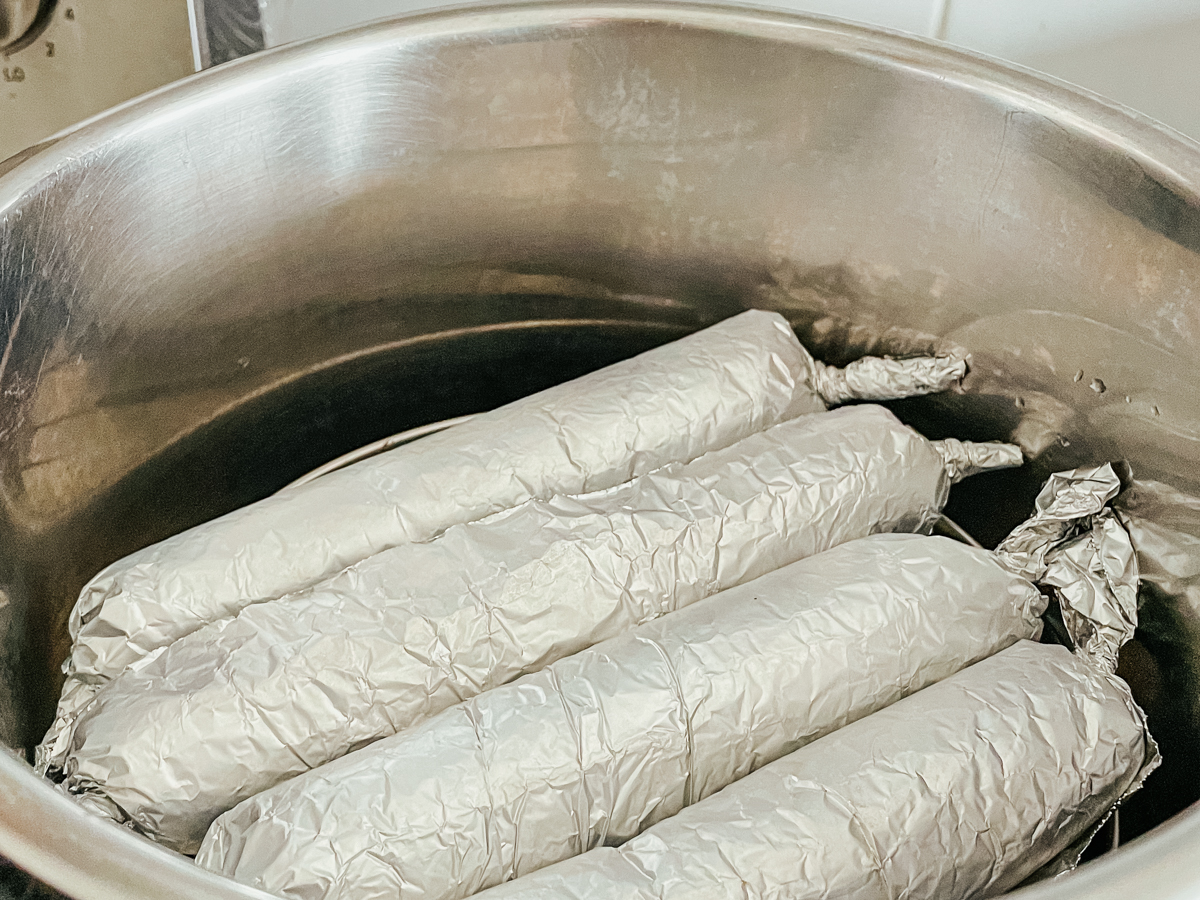
Thanks so much for these okara recipes, we have now tried 2 or 3 of your recipe choices and also repeated the sausage and patty recipes several times; playing around with spices/flavours is great fun – 5 stars for sure! 🙂 Sabina
Thank you so much Sabina! 💚
Hi Kelly – any news on Lap Cheung flavoured sausage by any chance?? 🙂
Thank you, Sabina
ps. Just making Kielbasa sausages, yummmm….
Great timing! To be honest I’d given up on the lap cheong for a bit because I couldn’t get the flavours and textures right and it was getting frustrating. But a few days ago I saw someone post this recipe in a Facebook group I’m in:
Pulse seitan pork into chunks, add tofu fat and the rest of the ingredients, mix, and rest in the refrigerator overnight. Stuff the casings or wrap with rice paper. Steam 30 minutes. Air dry in the refrigerator for a couple of days
I think maybe the key is the lactic acid and air drying. Haven’t tried it yet but it’s my plan for this weekend.
Hi! I made your soy milk and loved it. I’m currently making this recipe and am very excited.
How did you do the nutrition measurements? I plugged the info into Cronometer and I’m only getting 22g of protein per 195 kcal.
Thanks in advance!
-Spencer
Hey Spencer good question. To estimate nutrition facts for these recipes I use a plugin called Spoonacular API which might have a slightly different database from Cronometer. But it doesn’t make sense for the discrepancy to be so large… Weird that it’s only coming out to 22g protein per sausage. Pure vital wheat gluten has 75g of protein per 100g; considering this recipe uses 210g of vwg, that’s 157g protein which divided between 6 sausages gives at least 26g of protein per sausage, not including the other ingredients. Can I ask how many kcal and protein does your total recipe come out to? For reference, I plugged it into Cronometer and here’s what I got: https://cronometer.com/food.html?food=29030714&amount=1&measure=79128004&labelType=AMERICAN_2016
ah. I think the discrepancy is the amount of VWG. My bag says 30g for .25 cups, so 1.5 cups would be 180 grams. 1.75 cups being 210 grams.
I made it with 180 and i loved it but ill try my next batch with 210 🙂
Thanks!
Ok that makes sense. I’m glad it still worked out with a slightly lower gluten amount!
I would like to know how many cups of soyo okara you used for this recipe to get that consistency with the sausage. That would really make the recipe easier for your audience.
Thanks
It’s hard to give a cup measurement because as I discuss on my soy milk post, the volume of okara really depends on how well it’s been strained and even how tightly you pack the okara into the measuring cup. Generally for one batch of this sausage recipe you’d use around 1/2 cup to 1 cup of okara (use the lesser amount if your okara is dense and dry, use the higher amount if your okara is very wet). If you’re not sure, go for the lesser amount because too much okara will give the sausage a doughy texture instead of the snappy, bouncy texture we want.
I’m pretty excited for this recipe. I like to make my own tofu and I freeze a lot of the leftover okara after making a batch of soy pulp patties or hummus. I’m writing this comment just as the sausages are steaming on my stove. And boy let me tell ya, Kelly isn’t kidding when those sausages will swell up as the cook. I can tell just by looking at the foil packages they must have almost doubled in size. I wonder if I could make lunch meat this way, just using a bigger package.
I always find it very satisfying to see how much the sausages puff up as they steam!
It would be a neat experiment idea to see if this recipe works for making lunch meat. I’ve been meaning to try making my own deli meat (this vegan ham recipe has been on my list for some time) but to be honest, the Yves-branded deli slices go on sale at my grocery store so often that I usually stock up on those instead.
Can you use pressure cooker for this?
Since this recipe can be cooked in the Instant Pot on the pressure setting, I don’t see why it can’t be made in a regular pressure cooker as well. But since I don’t own one myself, I’m not sure how long you’d have to let it cook. You might have to do some experimentation.
Awesome awesome awesome! In all the variations I tried, you’ve got the flavour and the bite perfect. I was inspired to look up a hot Italian sausage recipe, lift the seasoning combination, and make myself a very satisfying pasta bowl.
That sounds delicious! Do you happen to have a link to the hot Italian sausage? I’d love to try it for myself
I made these yesterday and they turned out great. I only pressure cooked them in my Instant Pot for 30 minutes (and used natural pressure release) and that seemed to be enough. I used the pepperoni seasoning from Vegan Richa’s pepperoni recipe and it was perfect. Thanks for helping me to find another way to use my overabundant supply of okara.
Nice! Good to know that 30 minutes is long enough for the Instant Pot. If you’re interested, my mom recently showed me her recipe for okara flatbread, which uses up okara even more efficiently. I hope to post that recipe on here eventually.
Yes, please. I make soy milk about 5 times per week, so I have lots of okara. I usually use it to make vegan cheese, vegan biscotti, sauces, and now sausage (I’ve made your recipe twice). Any okara recipes would be appreciated.
This recipe looks really interesting and unique. I’ve been trying to find ways to use okara since I have alot from making soymilk. Maybe cooked rice, cubed potatoes or turnips can be used to imitate the fat in the sausages, but it won’t be as high calorie as fat.
So far, I’ve tested using rice to imitate the specks of fat, but the mouthfeel has been a little too gritty and not… well, fatty enough. The appearance is on point though so I’ll be experimenting some more. Report back if you try with the potatoes or turnips!
I seriously can’t believe how well these turned out. The texture is perfect and the spice mixes I’ve tried so far are really good. I’ve been experimenting to figure out a lap cheong recipe (without success, though they still taste delicious). I really look forward to when you post that one.
Everyone should make this recipe and you deserve so much credit for coming up with it! Thank you!
Thank you so much for your kind words 😍 I am still without success on the lap cheong myself lol. The biggest issue has been figuring out a substitute for those chunks of white fat, I feel like they are essential to the taste and mouthfeel of lap cheong but I haven’t been satisfied with my attempts to replace it so far. If your experiments work out please share them!!
Have you tried using starch left over from the WTF method? I’ve seen people use that as a fat
That’s a great idea. I’ve seen people do cool stuff with it on the Seitan Appreciation Society FB group but haven’t done much WTF myself because it’s a bit time-consuming. I’ll do some experimenting over the summer.